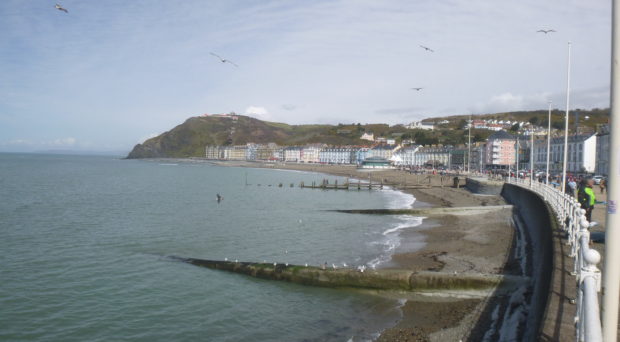
Conferences allow scientists from across the globe to get together and network; allowing for new ideas, opportunities and better science to be generated. This year the British Society for Parasitology’s (BSP) Conference was held in the Welsh seaside town of Aberystwyth from 8th – 11th April, and after four trains and several hours of travelling we finally arrived. Blue skies and sunshine greeted us the following morning so we set out to explore the town before attending the welcome reception and the opening talk given by Prof Peter Chiodini (UCL Hospital for Tropical Diseases). He reinforced the importance of raising the public understanding of science through examples of his own work and discussed how media portrayal of parasites may bias how people perceive them. The lecture was fun, entertaining and provided a great introduction to the conference, and the message that parasite profiles must be raised to improve public health was clear.
During the conference a range of excellent plenary talks were delivered from invited speakers:
Prof. Alex Loukas
Prof Alex Loukas (James Cook University) had travelled all the way from Australia to give the first of the fascinating plenary talks. He discussed how live hookworm parasite therapy allowed individuals with coeliac disease, a condition in which individuals are intolerant to gluten, to eat up to a full plate of pasta without any adverse effects. However, live worm therapy is difficult and unpredictable, so Prof Loukas and his team studied this worm further and identified parasite proteins capable of alleviating inflammatory symptoms by themselves. It is hoped that these proteins could forms the basis of new treatments to ameliorate coeliac disease and other conditions such as asthma and inflammatory bowel disease in the future.
Prof. Robert Poulin
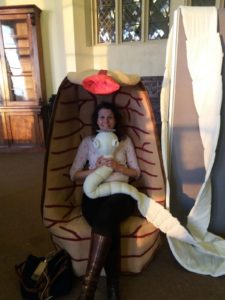
Prof Loukas had to concede that the second speaker of the day, Prof Robert Poulin (Otago University), had travelled slightly further, from New Zealand, to deliver his talk about how trematode worms have evolved social and divisional labour. Like ants and bees, these trematode worms also seem to share the workload. Prof Poulin explained that during infection of a snail host, trematode worms can divide into two different forms: large reproductive forms that resides at the back of the snail generating many offspring and small mobile forms that remains at the front of the snail to attack invading competitors from other species. If competition is particularly fierce more soldiers will be recruited to join the army with the reproductive transforming into soldiers, a system designed to maximise species survival.
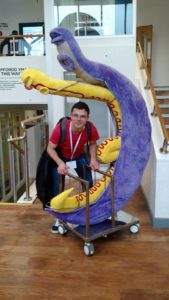
Dr. Shahid Khan
The challenges and frustrations on the journey to develop a vaccine for malaria were described by Dr Shahid Khan (Leiden University Medical Centre). He discussed the use of genetically attenuated malaria parasites, parasites which are infective but no longer dangerous to their host, as a vaccine candidate and the processes that must be undertaken to license a vaccine. Many biological and societal challenges still remain in the attempt to develop a malaria vaccine; one step at a time, however, Dr Khan and his collaborators are determined to overcome these with further clinical trials, with one even beginning back in The Netherlands during the conference. Good luck!
Prof. Wendy Gibson
Microscopy has revealed that trypanosome parasites are able to exchange genetic material whilst inside tsetse flies and this was the subject of the Prof Wendy Gibson’s (University of Bristol) lecture. Her team labelled one set of trypanosomes with a red fluorescent marker and another set with green. Within 30 minutes of mixing these trypanosomes sets in the fly, yellow trypanosomes appeared as the red and green parasites began exchanging material (red light + green light = yellow light). This technique has allowed Prof Gibson and her team to show that trypanosomes have sexual stages during their life cycle, contrary to previous beliefs, and pinpoint the location in which this occurs inside the tsetse flies.
CA Wright Memorial Medal Lecture:
Dr Annette MacLeod (University of Glasgow) was awarded the CA Wright medal for her dedication
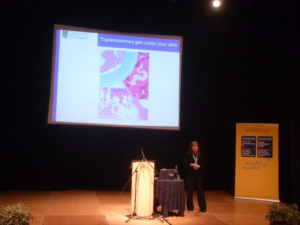
and ground-breaking work on trypanosomiasis. Her talk entitled ‘Trypanosomes get under your skin,’ gave a fascinating insight into research undertaken in her group and what still remains to be found. Trypanosomes (Trypanosoma brucei) are parasites that cause a disease called Sleeping sickness in sub-Saharan Africa. Until recently it was thought that these parasites only invaded the bloodstream, progressing to the cerebral spinal fluid in the later, more serious, stage of the disease if left untreated. Dr MacLeod’s work, however, has uncovered that trypanosomes can also come out of the bloodstream and invade the skin. The excitement about this discovery was clear to see from fieldwork video clips taken when the discovery was confirmed. She also discussed that trypanosomes display the Meselson effect in their genetic make-up and that humans are also adapting to the disease by acquiring genes that make them tolerant to this disease.
Special sessions
A range of more specialised sessions throughout the conference, including the incorporation of meetings of the British Association of Veterinary Parasitology and the British Ecological society and the Trypanosome and Leishmania Symposium, allowed researchers to focus on their particular areas of interest and learn about similar research being undertaken in their field. Everything from lab work, clinical trials, fieldwork, human parasites, animal parasites, the well-known parasites to the weird and wonderfully named ones, was discussed by students to professors alike, allowing for a very broad and diverse meeting.
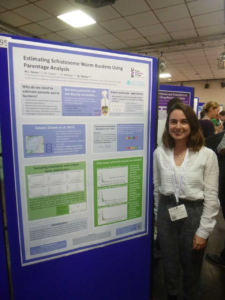
On Monday afternoon I had the opportunity to present my own work on the interactions between schistosomes, the microbiome and anti-helminthic drugs during the ‘ecological parasitology: multi-species interactions,’ session. I enjoyed engaging in conversations about my work afterwards which has helped generate new ideas and considerations for my project.
Two poster sessions also provided an opportunity for researchers to present and discuss research in a more informal setting and both were bustling with enthusiastic scientists ready to share ideas and display their work. Exhibitors were also present from journals and companies to discuss new technologies and projects.
The fun
The young parasitologist’s party, the ‘Parasites: the Good, the Bad and the Ugly,’ parasite public engagement session, the conference dinner and ceilidh provided everyone with some down time, an opportunity to refuel and make friends.
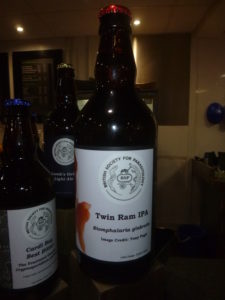
Of course, welsh lamb was on the menu and traditional bara brith cake provided during the breaks! Special parasite themed beers had even been created for the conference and the ceilidh finished with researchers dancing to create a snail shaped pattern as snails are intermediate hosts for many trematode worms.
To finish, an AGM was held for to update progress and elect new trustees of the society. All in all, the conference was a great success and a very enjoyable experience. Although it might have been far away and difficult to pronounce, like some of the parasite names, Aberystwyth was a great setting for the conference. I look forward to catching up with everyone and learning about how their research has progressed next year. The BSP’s Autumn 2018 Symposium will be held in Liverpool and the Annual Spring Meeting 2019 will be in Manchester. I hope to see you there!

Comments